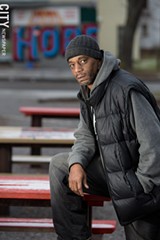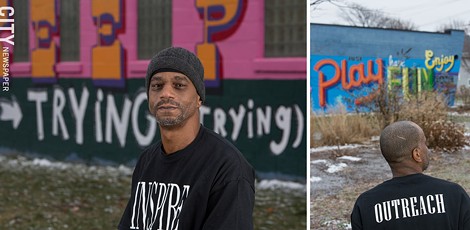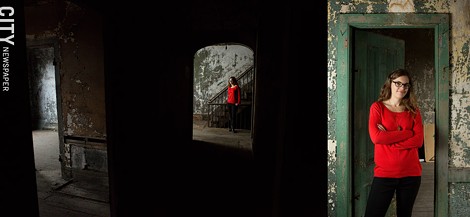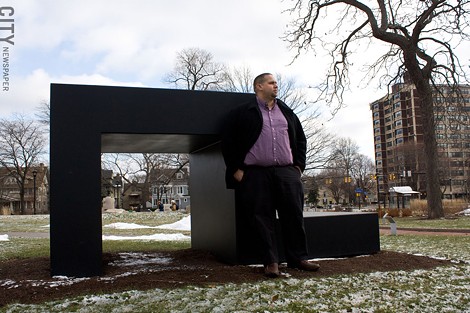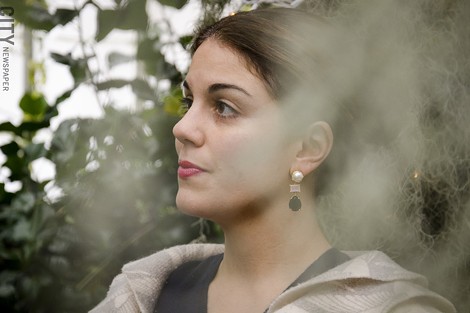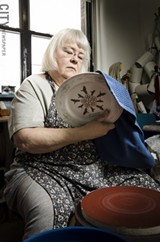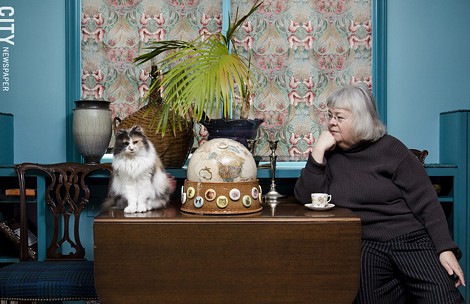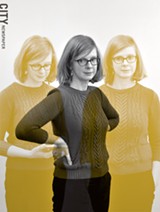The Rochester 10
Rochesterians doing great things in the community
By Jeremy Moule @jfmoule, Christine Carrie Fien @CCFien, Tim Louis Macaluso, Jake Clapp @Jake_Clapp, Rebecca Rafferty @rsrafferty, Adam Lubitow @adamlubitow and Casey Carlsen
[
{
"name": "500x250 Ad",
"insertPoint": "5",
"component": "15667920",
"parentWrapperClass": "",
"requiredCountToDisplay": "1"
}
]
The Greater Rochester area is filled with talented, driven people working to make the region a better place to live, work, and play. But often it seems that the same names dominate headlines, while others who are working tirelessly within their own spheres go under the radar. This annual project — the Rochester 10 — is designed to bring some of our community's hard-working background players to the forefront.
We are in no way saying these are the 10 most important people in Rochester. But every person on this list is contributing to life in the area in interesting, varied ways, and we believe that you should know about them.
One is a former drug dealer who is now trying to help young people go straight. Another is trying to breathe new life into old buildings while preserving Rochester's history. Yet another is balancing a life as an artist with forward-thinking charity work.
Read on to learn more about these Rochester residents making waves below the surface. Is there someone you think deserves to be profiled? Please leave a comment on this article at rochestercitynewspaper.com for future consideration.











Dynell Cook
[ NEIGHBORHOODS ] Dynell Cook is charmed and positively charged. He's a stick-figure street preacher sculpted by Catholic schools and low-level drug dealing. The epiphany that he says saved his life happened on the floor of a Rochester drug house, before the burns from the bullets that grazed his scalp that day hardened into scars.
"The drug dealer mentality was never who I was," he says. "I lived vicariously through other people, and I really screwed up a large portion of time in my life."
Cook, 41, spends his time on the other side of the streets now as Ibero-American Development Corporation's community engagement specialist. He makes "first contact" with the young men and women selling drugs on Rochester's streets and tries to convince them to let Ibero help them go straight.
"I remember how hard it was to make that transition by myself," he says. "How I played the Hokey Pokey, my mother would say — always have my left foot in and my right foot out of something. And not knowing that it was all or nothing."
Cook got involved with Ibero after moving to the west side of the city following his divorce. The drug activity he saw from his apartment would've made a good, gritty HBO series, he says.
"I could look out my window and see a hand-to-hand transaction," he says. "I could see them hiding and stashing. I'm going to the store, I'm getting offered things I can't pronounce, nor do I know what it is. And I was outraged."
Cook turned up at a meeting for Project HOPE (Healthy Outcomes through Participation, Education, and Empowerment) — an Ibero initiative targeting 20 blocks in Northeast Rochester. Residents of these streets identify marijuana markets as one of the area's biggest problems, contributing to higher stress, lack of opportunities for physical activities, low wages, chronically high unemployment, and poorer health outcomes.
Part of Project HOPE is the Rochester Drug Free Streets Initiative. And part of that is to persuade the young people working those drug markets to give Ibero a chance to help them leave the street life.
"A lot of these guys, maybe they picked up a felony along the way and they think that they'll never be able to get a job," Cook says. "And I'm out there telling them, 'Hey, that's not the end of the world. There's things you can go through, people you can see that can help you. Even with those charges.' So I try to kill the myths that keep them out there."
If the youth agree to participate, they'll be part of a community intervention process so that they understand the impact their activities have on the neighborhood. And attempts will be made to connect them with educational, job training, and-or employment opportunities.
But first, as the program's ambassador, Cook has to earn their trust — convince them he's not a snitch. And he has to talk them into giving up a guaranteed payday and a dangerously addictive lifestyle for...what? A GED? The possibility of an entry-level job?
"I just cut off your bread and butter, potentially. You're surrendering that," Cook says. "Nobody waits for anything anymore, but there I am trying to tell them, 'It gets greater later.' That's the fight."
-- Christine Carrie Fien

Evan Dawson
[ MEDIA ] For more than a decade, Evan Dawson could be spotted in the studio or out in the field reporting for 13WHAM news. But in January 2014, he embarked on a job change that surprised many in the Rochester community, both inside and outside the media.
Dawson became host of WXXI radio's 1370 Connections, a position formerly held by Bob Smith — a beloved local media personality who, for more than two decades, fashioned a two-hour daytime talk show around issues ranging from regional and national politics to gardening and home repair. (Smith resigned abruptly in 2013 due to illness.)
It was a bold move on Dawson's part, and filling Smith's shoes hasn't been easy. Even though Dawson is a veteran journalist, he admits to some flop-sweat moments in his new job. To begin with, he had little radio experience on which to draw.
"In college I hosted a midnight to 6 a.m. show," he says. "The rules were so minimal that I could create characters and have friends call in from other states, and basically have them entertain me to keep me awake."
But keeping the Connections brand that Smith built alive is critically important for both himself and WXXI, he says. The weekday noon to 2 p.m. slot is sandwiched between National Public Radio's popular morning and afternoon programs, and Dawson says that his goal is to keep all of Smith's listeners and to add his own.
Dawson has breathed new life into Connections, and in a relatively short period of time has made the show his own. Connections is sharper, moves at a quicker pace, and the topics and guests Dawson select feel fresher and more relevant.
Dawson says that he tries to pick topics he likes and that he spends a lot of time preparing. On most days, he says, he has more material than time to air it.
"There's always going to be people who prefer the previous host, and certainly we've heard from Bob Smith devotees," he says. "But I'm also really grateful to hear from a lot of people who listened to Bob and who essentially express that they miss Bob, but they love where we're taking the show."
Dawson says that he's always been a fan of NPR and that he probably should have considered a job change sooner. But there are relatively few positions locally or nationally like the one that became available at WXXI. Filling two hours with conversation compared to telling a story in a minute for TV news is a welcome change, Dawson says.
"I was the guy who was constantly asking my [TV] producer for more time," he says. "I was the guy who was constantly told, 'You've got to cut this down.'"
And he says that providing in-depth analysis is one of the fundamental challenges facing commercial media.
"There is a growing group of consultants and also some news professionals, whether they are in management or in newsrooms, who don't believe that American news consumers have any time or desire to spend their time with anything of depth or substance," Dawson says. "I fundamentally reject that and I believe that view is cancerous to our discourse."
Dawson says that he doesn't have firm data showing that he's growing the Connections audience, but that he senses he is.
"We constantly have listeners who tell us, 'I was late to my appointment because I sat in my car listening and couldn't get out,'" he says. "That's always our goal: to make you late."
-- Tim Louis Macaluso

Caitlin Meives
[ PRESERVATION ] Caitlin Meives' theory is that a lot of people are preservationists; they just don't identify themselves that way.
Preservationists are too often thought of as a stodgy bunch concerned with rescuing grand, old buildings. But Meives says that the people who live in urban communities or who visit and hang out in them also fit the bill. They're keeping traditional neighborhoods vital and contributing to the city's cultural life; they're ensuring that something historic is protected by making it relevant.
"You're a preservationist, because that's what preservation is about," she says.
Meives is a preservation planner with the Landmark Society of Western New York and part of her job is to help people give new life to old buildings. Sometimes that means campaigning against the demolition of a structure; Meives was one of many voices who urged the city not to let the Genesee Brewery demolish the old Cataract building. (The building was torn down.)
More often, she says, the job entails providing technical assistance to owners of historic homes and buildings, or connecting those owners with specialized contractors.
But this year, Meives took on a new effort. Along with Laura Moore Smith, an attorney at Harter, Secrest, & Emery, Meives co-founded Young Urban Preservationists — the YUPs. The Landmark Society-affiliated group is meant to expose more people, particularly those in their 20's, 30's, and early 40's to the broader idea of preservation.
It's a demographic that fits right into Meives' theory that many people are undeclared preservationists. Younger people are buying older city homes and fixing them up. They're choosing to live in city neighborhoods. They're starting businesses and locating them in previously ignored buildings.
"The reason there's a market for all of this rehab [happening in the city] is because of the young people," Meives says. "There are empty-nesters, too, that are moving back to the city, but a lot of it is the millennials. They want to live in walkable communities and they want to live in authentic, cool spaces that have character."
The YUPs have, so far, focused on events. They organized the Bikes, Beer, and Buildings bicycle scavenger hunt downtown, and held a reopening party for St. Joseph's Park at the corner of Pleasant Street and North Clinton Avenue.
But they have some small-town field trips in the works, too. They'll visit places such as Perry or Medina, Meives says, which have seen substantial preservation and revitalization efforts. And there's talk of a mixer with Buffalo Young Preservationists.
"We hope to do bigger and better things," Meives says.
-- Jeremy Moule

George Dardess
[ SPIRITUALITY ] Much of what George Dardess says he trusted in life was based on empirical knowledge, intellectual pursuits, and the security he found in academics. He earned his doctorate in 17th century English poetry, and says that he found teaching at the college level relatively easy.
"You could get away with just being an intellectual," he says.
But in the late 1970's, Dardess was hired by Allendale Columbia to head up the private school's English department.
"For me it was all about the mind until I went there," he says. "I suddenly had to deal with the whole person." Dardess says that for the first time, he was challenged to think with his heart instead of his intellect.
"I was an intellectual brat and the only thing that seemed to matter in my world was that you were smart," he says. "I had to get over that."
That meant embarking on a decades-long spiritual journey.
"Being a person who looked at the world solely in intellectual terms, it was like being let out of prison," Dardess says. "I learned that I was related to every other person and it doesn't take any great intellectual effort. The other person doesn't have to be brilliant or smart, just human. And I have to be human with that person."
Though Dardess says that he had not been a religious man up to that point in his life, he was baptized in the early 1980's and became a Roman Catholic. And it was through Catholicism in the tradition of Thomas Merton, a Trappist monk and social activist, that Dardess says that he also discovered Islam and his own sense of activism.
Dardess says that he remembers being horrified and releasing a spontaneous cry in 1991 when he saw on TV the US launching its first attack on Iraq.
"I'm sitting here with all of my education and I felt great shame in my ignorance," he says. "With all of my fancy education, I didn't even know where Iraq was. I couldn't have told you a thing about it or Islam. But here was this destruction going on, all done in my name and with my tax dollars. I felt that I am complicit."
Dardess learned Arabic, read the Quran, and embraced Muslim cultures.
"I felt deeply that Desert Storm was portrayed unjustly as a triumphant exercise of American goodness over the darkest evil, and war that had been cleansed of violence through 'surgical strikes' and 'smart bombs,'" Dardess wrote in an article that appeared in the St. Anthony Messenger.
Dardess went on two write two books and co-author two more on Islam and Christianity. He gave lectures around the country in an effort to share that Muslims are human beings with a rich and lustrous history and that they have been maligned by centuries-old violent stereotypes.
Much of Dardess's work was sidelined about two years ago due to illness. He also retired from Allendale Columbia, but he says that he completed what he set out to do: sharing his journey from Christianity to Islam. He spends what time he can now as an activist serving others, particularly migrant farmworkers.
"The challenge in life is learning how to keep your heart open," Dardess says. "Opening your heart to others' dismay and anger can be powerful. That's all I've done."
-- Tim Louis Macaluso

Anthony Plonczynski
[ POLITICS ] When it comes to Rochester politics, Anthony Plonczynski, 32, has probably heard every rumor and just as likely spread a few himself. He's a pot-stirrer who keeps things at a rolling boil — and a good-natured conscience-pricker who has the ear of many of the city's politicos, past and present.
"I do worry that I'm ticking off the wrong people, because I'm told that I'm ticking off the wrong people," he says. "I'm listening, I really am. I just have to find my own way."
Plonczynski's resume is impressive...and exhausting. He's legislative aide to Rochester City Council member Jackie Ortiz; associate director of the David T. Kearns Center at the University of Rochester; active in Rochester's Latino community; managed political campaigns for candidates for City Court, City Council, Rochester school board, and County Legislature; he's chair of the city's 21st Legislative District committee; and he's studying for his doctorate.
He's also engaged to be married.
Plonczynski grew up in Northwest and Northeast Rochester and graduated from East High School. He wasn't destitute, he says, but felt like his family lacked the knowledge and connections to improve themselves. So now that he's found a path, he says that he's determined to help others follow.
The Kearns Center, for example, works with low-income, first-generation college students to help them navigate all aspects of the college experience from picking a major to applying for graduate school.
A lot of young people come into the center declaring their intentions to be a doctor or a lawyer, Plonczynski says, either because that's all they know or because of family expectations. But their interests and their aptitude may lead them in other directions, he says, with the center's help.
In terms of politics, most of the campaigns that Plonczynski has managed have been for Latino candidates. Latinos are woefully underrepresented at all levels of government, he says.
"There's so much talent on the sidelines that gets pushed out or wasted," he says. "Our lack of representation is stunning. We had only one person representing us in the County Legislature, and now they're gone. Latinos don't seem to be part of the plan."
Plonczynski cites the recent controversy at the Rochester Housing Authority as an example. Alex Castro, a Latino, was dismissed as RHA chief and replaced with Adam McFadden, a member of City Council and supporter of Mayor Lovely Warren. Many saw the move as cronyism.
McFadden had to step down from the interim position after HUD said that he couldn't serve RHA and Council. But it's clear from talking to Plonczynski that hard feelings remain.
"Growing up poor, wearing the same pair of pants to school every day for a year — I've lived RHA conditions," he says. "So to turn [RHA clients'] lives upside down and to play political hot potato with such a vulnerable community really makes me mad."
Plonczynski says that the Latino community will keep reaching out to people in power to try to build relationships. But, he says, the other side has to reach back.
-- Christine Carrie Fien

Norwood P.J. Pennewell
[ DANCE ] Norwood P.J. Pennewell has performed with Garth Fagan Dance for 37 of the company's 44 years. Early on, his abilities inspired Fagan to set several major works on him, including "Moth Dreams," for which Pennewell earned a 1988 Bessie Award (New York Dance and Performance Award), dance's equivalent of an Academy Award. Today, the 56-year-old Pennewell is now rehearsal director and assistant to Fagan, who is 74. But most telling of his place in the company — and by extension the dance world at large — Pennewell has choreographed four pieces for Fagan. Fagan has allowed no one else such choreographic privileges.
Garth Fagan Dance has become world-renown for its rule-breaking experimentation and its sense of weight of modern dance, speed and precision of ballet, and the torso-centered movement and energy of Afro-Caribbean. It has been cited for its excellence and originality with a New York Governor's Arts Award and has claimed five Bessie winners: Fagan, Pennewell, Steve Humphrey, Natalie Rogers, and Sharon Skepple.
"Garth has put a lot of faith in my development as a person, a dancer, and a choreographer," Pennewell says. "He's put me at the creative forefront for continuing his legacy and it's a major responsibility to maintain a certain standard, to uphold his tenets."
Those tenets — cutting edge choreography, interesting movement invention and music, thought-provoking rhythmic patterns, and a focus on the overall theatrical experience — are the principles Pennewell strives for when creating in the Fagan technique.
"How that plays out aesthetically and transfers to my own creative voice, I'm still in the process of seeing," Pennewell says.
His most recent piece, "After Hours," which premiered last December, is distinctly Fagan: It has the out-of-nowhere leaps and jumps and the counter-rhythmic movement patterns that distinguish Fagan's choreography. But it is still uniquely Pennewell, featuring exciting ensemble work and, perhaps, more contemporary music than Fagan would have chosen.
Pennewell has a sophisticated choreographic eye and talent, Fagan said to City Newspaper. "I see him breaking rules and growing. Talent he has in abundance, and the workmanship, he's getting that under his belt too."
Pennewell was born in Fayetteville, North Carolina, and grew up in Schenectady, New York, where his first encounter with theater came as a sophomore in high school. Irked with his gymnastics coach, the young Pennewell accompanied a friend to drama club tryouts and was convinced by the director to audition.
"He turned out the lights, put on classical music and told us to just move the way we felt," Pennewell says. "I started really feeling the music, doing little leaps and jumps. Next day I was on the call-back list."
Now, when Pennewell hears music which sparks his choreographic impulse, he listens first for rhythmic patterns within the music, then closes his eyes and tries to visualize them. Next, he thinks about how his mentor would combine or contrast the rhythmic patterns with movement.
"I learned from Garth, and continue to learn from Garth," Pennewell says. "I respect him and want to excite him with my own work."
"P.J. and I share a vulnerability and that's what he needs," Fagan says. "I've never been able to work with dancers who aren't vulnerable. If I trust them and they trust me I can push them to that new place, that subtle place, that outrageous place. And that is where real art resides. In whatever medium. Where you find the new and redefine the old."
-- Casey Carlsen

Anahita Williamson
[ ENVIRONMENT ] Engineers are problem solvers. They have a knack for finding solutions to complex issues; it's as much about training as it is about the way their minds work.
As an engineer, Anahita Williamson has worked to solve problems that exist at the intersection of manufacturing and the environment. The Brighton resident has built her career around helping companies and industries lessen their environmental footprint — first at Xerox and now at the New York State Pollution Prevention Institute (NYSP2I for short).
Her work with Xerox began when she was a grad student at Clarkson University, and the company eventually hired her as its first resource conservation officer. She helped design a new chemical toner process, which gave her an opportunity to substitute chemicals that are more environmentally benign.
Williamson has led NYSP2I for the last six years, and it's "the most exciting position that I've had," she says. The reason: she's not just helping a single company improve its manufacturing processes; she's helping manufacturers across the state green their products.
NYSP2I is a state-funded organization with university partners, including the Rochester Institute of Technology. (It's housed on the school's campus.) It offers a few different services to businesses, from assessing the true environmental impact of a product — also called a life-cycle analysis — to helping them develop and implement sustainability plans.
Part of the NYSP2I's mission is to show companies why they should make these improvements. And with business, one of the most effective arguments is cost savings. As more manufacturers find that improving environmental performance also boosts their bottom line, Williamson says, the case becomes easier to make.
"We have the opportunity to work with companies to really look further upstream in their processes and identify opportunities to not have the waste from the beginning," she says.
Using less energy and fewer raw materials, for example, can provide savings, she says. And if a company can find a less-toxic alternative to a chemical, she says, the change can save regulatory compliance costs.
Williamson points to an institute-backed project as an example. A University at Buffalo professor has been researching an alternative to hexavalent chrome, a toxic chemical widely used in the metal finishing industry. If the professor can show that the switch is feasible, Williamson says, the industry may be able to eliminate use of the chemical.
Williamson says that she also wants to be an ambassador for engineering in general. Her dad was an engineer, so she was exposed to the work early. Her mom encouraged her to pursue a career in the field, she says, particularly if she could focus on improving the environment.
"One of the things that I want to do now and I've started to do now is to try to get more young people in general interested in engineering, but also, especially, young women," Williamson says.
-- Jeremy Moule

Sabra Wood
[ ART ] It's not uncommon to hear Wood referred to as a sort of fairy godmother of Rochester. Beyond the demands involved in making and showing her clay creations, Wood stays busy with a number of civic-minded projects, the success of which continually provides proof that grassroots efforts can encourage people to help one another.
Sabra Wood left the corporate world in 2001 to focus on building a pottery practice, which has evolved over time to become what it is today: Cat Clay, named for Wood's beloved feline companion, Clifton Wood. Her creations vary widely and range from the cleverly functional, such as egg separators, objects which keep cookies from going stale, and toad houses; to the decorative, including the lovely "Highland Park" vessel series, with dreamy glazes reminiscent of the hues found in one of Rochester's favorite blooming parks.
In recent years, Wood has started to incorporate decals to her hand-built ceramic work and to second-hand vintage china. These images include pop-culture references to Doctor Who, Star Wars, and Star Trek. And Wood is a huge fan of clever wordplay — these images are often paired with what she calls "sweetly snarky" phrases. Some of her most popular work includes her "Mug Shots" series — ceramic mugs featuring decals of various celebrity mug shots.
Wood participates in most of the monthly First Friday open studio nights with one-night pop-up art shows, or what she calls "Pop Up Roc" events. In addition to showing and selling her own creations, Wood invites a different guest artist — typically an emerging artist — to show and sell their work each time. Though she charges no rental fee and takes no commission on works sold, she says hosting new artists is mutually beneficial because it brings new people into Cat Clay.
For example, 24 years ago, Wood and a friend initiated "Sample Soap," a non-profit charity which accepts no money, only unwanted sample- or full-sized toiletries. Wood and her team of loosely-organized volunteers redistribute the goods — through homeless shelters and other organizations — to "Rochester's neediest citizens, which is a sadly huge segment of our population," she says. "It's runaway kids. It's the truly homeless. It's battered women. It's families burned out of their houses. It's AIDS survivors."
Currently, there are about 20 formal collection sites around Rochester, including corporate locations and small businesses alike, which doesn't include drives held by different organizations, or donation locations outside of the city. In 1995, Sample Soap was recognized with a National Make a Difference Day Award, and Sample Soap has been featured in People Magazine. To date, Sample Soap has received more than 60 thousand pounds of donated toiletries.
Each First Friday in January, instead of an art show, Cat Clay hosts the cozy, community-oriented "Winter's Warmth: A Soup-er Benefit." Wood partners with the Healthy Sisters Bean and Soup Project — an arm of Catholic Family Center — which assists women in recovery in reentering the workforce by having them do the various aspects involved in running Healthy Sisters.
In preparation for the event, Wood makes about 40 bowls, and received about that many from the community. Local businesses help provide food and other supplies. The popular event is first-come-first-serve, and for $20, you get a handmade bowl, your choice of soup or rice mix, and a selection of appetizers and desserts. Full proceeds benefit Healthy Sisters.
Wood is also on the roster to host a radio show through WAYO, which she says will include interviews with visual artists, highlighting the music the guests listen to when they are creating. Learn more about Sabra Wood, Cat Clay, and watch for updates at facebook.com/catclayroc.
-- Rebecca Rafferty

Linda Moroney
[ FILM ] Talking with filmmaker Linda Moroney, it's clear that what excites her the most — possibly even more than moviemaking itself — is finding interesting and talented people to collaborate with.
"I enjoy working on projects that I love with others," Moroney explains. "People bring their own stories and life experiences to the table and generally make all of these projects much richer." It's that desire to constantly find new projects and build partnerships within the community that's been evident in every aspect of her career from the beginning.
Moving to Rochester from New York City in 2006, Moroney immediately set about making herself an indispensable part of Rochester's film community. She has since curated nonfiction film programs for the Eastman House, Little Theatre, High Falls Film Festival, Rochester International Jazz Festival, and Greentopia — just to provide a sampling. Basically, if you've gone to any local theater to see a provocative, acclaimed new doc, there's a good chance you're there in part because of Linda Moroney.
A veteran of the independent film community for more than 15 years, Moroney began her filmmaking career interning for Academy Award-winning animator Faith Hubley, and later working alongside Hubley's daughter Emily, with whom Moroney helped create the animated "Origin of Love" sequence in the film adaptation of "Hedwig and the Angry Inch."
Later she transitioned into nonfiction filmmaking, in the process discovering that documentaries are where her passion truly lies. "It's my drug of choice," Moroney admits.
And she's been delighted with the way the genre seems to have blossomed in recent years. Whereas once documentaries were primarily thought of as the "vegetable of the filmmaking table," audiences have gradually learned that it's an artform as wide-ranging, challenging, and thrilling as any other. She also recognizes how lucky Rochester filmgoers are to have a plethora of quality film festivals, a world-renowned museum at the Eastman House dedicated to the medium, and a nearly unheard of five-screen independent theater.
With her production company, Low to the Ground Productions, she is in the midst of putting together her own documentary feature, "Turn the Page," about The Storybook Project, a program in which incarcerated parents are allowed to record themselves reading books for their children. She's also working on a film with director Mickey Lemle about the Dalai Lama. For the past four years, Moroney has acted as director of Greentopia | Film, overseeing all the film programming, and putting together a compelling lineup of documentaries with a focus on environmental concerns and sustainability.
Moroney is doing her part to help train the filmmakers of tomorrow, teaching a course on documentary filmmaking at St. John Fisher College, and as founder of the Rochester Teen Film Festival along with its corresponding summer day camp. The camp offers workshops on the art of filmmaking and the science of digital video production for budding directors. With co-founder Brian Bailey, Moroney is working to secure grants that will allow youth from low-income families to take part as well.
In 2011, Moroney established the Rochester Documentary Filmmakers Group, which holds monthly meetings at the RCTV Media Center. The group acts as a resource for documentary filmmakers in Rochester to learn about the ins and outs of the business, from copyright to distribution, and providing a sounding board to get feedback from their peers.
She's committed not only to cultivating new filmmaking talent, but also introducing the general public to the artform, by acting as curator for the popular One Take Documentary Series at the Little Theatre. The program is advertised as bringing "festival favorites and unheralded gems" to filmgoers, and Moroney works hard to fill the schedule with a diverse collection of films from exciting new voices in nonfiction filmmaking. "These are voices that need to be heard," she explains.
When asked what makes Rochester audiences particularly receptive to these types of films, Moroney suggests that it may be our city's history of social activism and the general desire to make our world a better place. At their best, this is what documentaries can inspire in viewers.
"I think working collaboratively is key," Moroney says. "It may be vital but it, perhaps as importantly, provides wider world viewpoints, which we need now more than ever."
-- Adam Lubitow

Kaci Smith
[ MUSIC ] When Kaci Smith was 10 years old and interested in joining her school's band, she was determined to play an instrument people wouldn't expect from a young girl.
"I wanted either saxophone, tuba, or drums," Smith says now, recalling the day she tested different instruments to find her place in the band. "I wanted something completely non-stereotypical at that age."
She tried out the saxophone, and did really well. But the teacher handed Smith a clarinet and asked her to give it a shot. Smith deliberately tanked her tryout, resolute in not playing to stereotypes. Smith found her part behind the snare drum.
Smith continues that defiant spirit — the notion that young girls don't have to fit into certain sections of a band, or society — as the founder and program director of Girls Rock! Rochester, a week-long music camp that works with girls and trans* youth ages 8 to 16. Girls Rock! campers are split into groups and set on the mission to form a band and write an original tune.
Prior musical experience isn't necessary, and the camp provides all of the instruments for participants to write their music — whether it's a rocker, a bluesy cut, or hip-hop influenced. "We do teach some of the basics, like your notes and scales," Smith says. "But it's really more about expression and seeing what works."
The camp — a 501c(3) nonprofit — goes well beyond the music, though. According to its mission statement, Girls Rock! Rochester uses "music creation and performance as tools for cultivating self confidence in girls and trans* youth. We foster creativity while building a supportive community of peers and mentors, to help girls develop life and leadership skills that will effect positive social change."
Along with instrument lessons and songwriting, the camp includes workshops on female figures in music history, self-defense, zine making, and band merchandising (including screen printing). And each camp is capped with a large showcase performance at a venue where the bands can rock the songs they've been working on. The 2014 camp sessions also offered, for the first time, a chance for the bands to record their songs — those can be found at girlsrockrochester.bandcamp.com.
"There are kids here who aren't able to access a lot of different kinds of programming because of their financial abilities," Smith says. Girls Rock! offers financial aid for the program and will not turn away anyone for lack of funds. "That's where I saw it fitting into Rochester. We can service these kids who might not necessarily get music education."
The Rochester camp is part of the larger Girls Rock Camp Alliance, which unites and supports camps in the U.S., Canada, and Europe.
Smith, who is 30, started Girls Rock! Rochester in late-2011 — the first camp was held summer of 2012. While in school, Smith played the drums with concert and marching bands, but when she reached her senior year at Wheatland Chili High School, she had to make a decision: continue in band or pursue art courses. She followed the art path — Smith went on to graduate from Alfred University with a BFA in Photography and a minor in art education — but her mother bought her a drum kit for Christmas. Smith's first rock band was called Escape Velocity, which included two other women.
"In high school, when I started the band, I learned about Bikini Kill, and Bratmobile, and all of those riot grrrl bands," Smith says. "I always joked to myself that I was born in the wrong generation, because I felt like the early-90's feminist movement was something I identified with."
After she read about the Girls Rock! camp in Portland (the original camp), Smith volunteered as a drum instructor with the Willie Mae Rock Camp for Girls in New York City in 2007 and 2009. She says she loved the experience, but didn't think a camp like that could happen in a smaller city like Rochester. But in 2011, while attending a zine reading in Buffalo, Smith met a woman who had started a camp in Athens, Ohio, a city with about 25,000 people. She returned to Rochester inspired.
In early 2012, Girls Rock! Rochester held its first fundraising event with the Broad's Regional Arm Wrestling League, and opened its inaugural camp session that July with 18 campers. The 2014 session, the camp's third year, had 45 kids. And this year, along with the 2015 camp, Smith hopes GR!R can begin to offer year-round, affordable music lessons.
During her day job, Smith is an ESL teacher at Winslow Elementary, and a mentor for a 9th grade girl at Young Women's College Prep, where she taught last year. She is also heavily involved in caring for her mother, who had a stroke in 2012.
"She was very much like, 'You can do whatever you want. Men can do women's roles; women can do men's roles; there shouldn't be roles," Smith says about her mother. "I think she was a huge influence in letting me know that it didn't matter."
On top of everything, Smith drums for the punk band Richard Snare, and runs a label, Casual Punks, with her friends.
Along with encouraging young girls, Smith says she hopes Girls Rock! Rochester can help form a strong community of female musicians, which is desperately missing in Rochester.
"Even while playing with my band, having to deal with all sorts of different types of sexism within the music scene, or comments after a show, I was like, 'OK, something needs to change.'"
-- Jake Clapp

